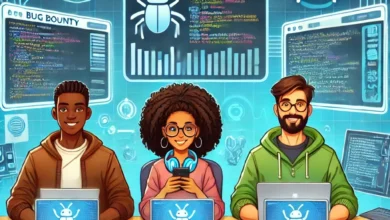Mastering Bug Bounty Hunting: Advanced Tactics for the Aspiring Elite
From Penetration Testing to Ethical Hacking: Sharpening Your Cybersecurity Edge

In the dynamic realm of cybersecurity, the journey from a novice to an elite bug bounty hunter is both challenging and exhilarating. This article serves as your beacon for those who have ventured beyond the basics of bug hunting and yearn to elevate their skills to unparalleled heights. Aimed at individuals with a foundational understanding of bug hunting, our goal is to catapult your expertise to the forefront of cybersecurity excellence, where you stand among the ranks of the most accomplished and revered in the field.
We are on the brink of exploring the deeper, more intricate layers of cybersecurity strategies, tools, and techniques that are the hallmarks of top-tier bug bounty hunters. You’ll be guided through the labyrinth of advanced practices that are essential for identifying and exploiting vulnerabilities with precision and ingenuity. This journey includes a deep dive into automated vulnerability scanning, a method that leverages software to automatically scan systems for known vulnerabilities, providing a fast and comprehensive overview of potential security weaknesses.
Moreover, we delve into sophisticated penetration testing methodologies, which go beyond standard testing to uncover deeply rooted vulnerabilities in complex systems. These methodologies often simulate real-world hacking scenarios to evaluate the resilience of systems against cyber-attacks.
Lastly, the nuanced art of ethical hacking will be unveiled, where hacking skills are used for good — to improve system security by identifying and fixing vulnerabilities before they can be exploited maliciously. Ethical hacking is a critical component of modern cybersecurity strategies, requiring a deep understanding of potential attackers’ methodologies to effectively safeguard systems.
This intro marks the beginning of an enlightening expedition into the advanced realms of bug bounty hunting. The knowledge and skills you can gain here will augment your capabilities and contribute significantly to the broader cybersecurity community. Let’s embark on this journey together, with the ambition of not just chasing bugs but mastering the craft of cybersecurity in its entirety.
Advanced Bug Hunting Techniques: Automated Vulnerability Scanning and Penetration Testing
As the cybersecurity landscape evolves, so must the techniques and tools that bug bounty hunters employ. Two pillars of advanced bug hunting are automated vulnerability scanning and sophisticated penetration testing methodologies. These approaches enable hunters to identify and exploit vulnerabilities more efficiently and effectively.
Automated Vulnerability Scanning:
Automated vulnerability scanning tools are indispensable in the arsenal of a modern bug bounty hunter. These tools systematically scan web applications, networks, and systems for known vulnerabilities, offering a broad sweep that ensures no stone is left unturned.
- Example: Tools like Nessus or Qualys can be configured to automatically scan for thousands of vulnerabilities across network devices, servers, and web applications. For instance, a bug hunter can use these tools to discover an unpatched SQL injection vulnerability in a web application, which could be further explored and reported.
Benefits:
- Efficiency: Automated scans can cover vast digital territories in a fraction of the time it would take to do so manually.
- Comprehensiveness: These tools are regularly updated with the latest vulnerability databases, ensuring emerging threats are also covered.
- Prioritization: Post-scan reports help hunters prioritize vulnerabilities based on their severity, allowing for focused manual testing on high-risk areas.
Advanced Penetration Testing Methodologies:
While automated tools can uncover a wide array of vulnerabilities, advanced penetration testing methodologies involve a more nuanced and targeted approach. This involves simulating real-world attack scenarios to uncover deeper vulnerabilities that automated tools might miss.
- Example: Techniques such as fuzzing, where inputs are deliberately designed to be anomalous or unexpected to provoke errors and vulnerabilities, can uncover weaknesses in input validation. Another example is chain exploitation, where multiple low-severity vulnerabilities are combined to facilitate a high-severity exploit.
Benefits:
- Depth of Discovery: These methodologies can uncover complex vulnerabilities that require a specific sequence of actions to exploit.
- Real-World Simulation: By mimicking the tactics of actual attackers, penetration testers can provide insights into how an application might fare under a targeted attack.
- Customization: Penetration tests can be tailored to an application’s specific architecture and technologies, providing more relevant findings.
Automated vulnerability scanning and advanced penetration testing represent critical components of an advanced bug bounty hunter’s toolkit. While automated tools provide a broad overview of potential vulnerabilities, penetration testing delves deeper, offering a detailed and nuanced understanding of specific weaknesses. Together, these techniques enable bug bounty hunters to identify vulnerabilities more effectively and understand the real-world implications of these vulnerabilities on the security posture of the systems they are testing. In the next section, we will explore the ethical considerations and methodologies that guide the practice of ethical hacking, ensuring that our pursuit of security strengthens rather than undermines the digital infrastructure we seek to protect.
Ethical Hacking: Navigating the Moral Compass in Cybersecurity
Ethical hacking, often called white-hat, plays a pivotal role in fortifying digital infrastructures against malicious attacks. By employing the same techniques as those used by malicious hackers, but with permission and for the greater good, ethical hackers help identify and rectify vulnerabilities before they can be exploited. This section delves into the ethical considerations and methodologies that guide the practice of ethical hacking.
Ethical Considerations:
The foundation of ethical hacking is built on trust, legality, and the intention to improve security. Ethical hackers must operate within a framework of strict ethical guidelines:
- Permission: Ethical hackers must always have explicit, documented permission from the owner of the system before attempting any testing. Operating without consent can lead to legal repercussions and ethical breaches.
- Disclosure: Vulnerabilities discovered during testing should be promptly and privately reported to the organization, allowing them the opportunity to remedy the issues before they are publicly disclosed.
- Respect for Privacy: Even with permission, ethical hackers must respect the organization’s and its users’ privacy. Accessing, disclosing, or modifying private data without explicit consent is strictly prohibited.
Methodologies:
The methodologies employed in ethical hacking are designed to systematically identify vulnerabilities, assess the risks they pose, and recommend corrective actions.
- Reconnaissance: The first step involves gathering as much information as possible about the target system. This can include public domain information, network enumeration, and social engineering tactics.
- Example: Using tools like Shodan or Maltego, ethical hackers can uncover exposed assets and potential entry points into the system.
- Vulnerability Assessment: This phase involves identifying potential vulnerabilities in the system. Automated tools, alongside manual testing techniques, are employed to scan for known weaknesses.
- Example: Running a tool like OpenVAS against a network can help identify unpatched vulnerabilities that could be exploited.
- Exploitation: Ethical hackers attempt to exploit identified vulnerabilities under controlled conditions to understand the potential impact of an attack.
- Example: Exploiting a found SQL injection flaw on a test environment to demonstrate how an attacker could extract sensitive information.
- Reporting: A detailed report is provided to the organization, outlining discovered vulnerabilities, the methods used to exploit them, and recommendations for remediation.
- Remediation and Re-testing: After the organization addresses the vulnerabilities, re-testing ensures the fixes are effective and that no new vulnerabilities have been introduced.
Ethical hacking is a critical component of a comprehensive cybersecurity strategy, providing an insider’s perspective on potential threats and vulnerabilities. By adhering to ethical guidelines and employing systematic methodologies, ethical hackers can significantly enhance the security posture of digital infrastructures. Aspiring bug bounty hunters and cybersecurity professionals must understand and embrace these principles, ensuring their efforts to protect and secure digital assets are effective and morally grounded. The ethical considerations and methodologies outlined here serve as a beacon in pursuing cybersecurity excellence, guiding professionals toward responsible and impactful practice.
Continuous Learning and Skill Enhancement in Cybersecurity
The field of cybersecurity is in constant flux, with new vulnerabilities, attack vectors, and defensive technologies emerging regularly. For aspiring bug bounty hunters and cybersecurity professionals looking to stay ahead of the curve, ongoing education is not just beneficial—it’s essential. This section offers guidance on leveraging advanced courses, webinars, and workshops to continually hone your skills and knowledge in the rapidly evolving cybersecurity landscape.
Advanced Courses:
Several platforms and institutions offer advanced courses in cybersecurity, ethical hacking, and penetration testing. These courses often cover the latest tools, techniques, and methodologies used in the industry.
- For example, platforms like Coursera, Udemy, and Cybrary offer courses designed by cybersecurity experts and institutions. Topics range from advanced network penetration testing to reverse engineering and malware analysis. Look for courses that offer hands-on labs and real-world scenarios for the best learning experience.
Webinars and Online Conferences:
Webinars and online cybersecurity conferences provide an excellent opportunity to learn from leading experts in the field without the need to travel.
- Example: The DEF CON and Black Hat conferences, among the most prestigious in the cybersecurity world, offer online access to talks and workshops. These events cover a wide range of topics, from cutting-edge research findings to demonstrations of new vulnerabilities and hacking techniques.
Workshops and Hands-on Labs:
Participating in workshops and hands-on labs is invaluable for applying theoretical knowledge in practical scenarios. Many organizations and communities offer live sessions where participants can practice their skills in controlled environments.
- Example: Hacker101 and Hack The Box offer interactive labs and challenges that simulate real-world vulnerabilities and systems for ethical hacking practice. These platforms provide environments for everything from web application hacking to cryptography and binary exploitation, catering to various skill levels.
Capture The Flag (CTF) Competitions:
CTF competitions are not only a fun way to test your hacking skills but also a great learning opportunity. These events challenge participants to solve security-related puzzles and exploit vulnerabilities in mock environments.
- Example: Participating in CTF events hosted by platforms like CTFtime or during cybersecurity conferences can significantly enhance your problem-solving skills and technical knowledge. Many CTFs also provide write-ups and debriefs after the event, offering insights into solving each challenge.
The path to becoming a successful bug bounty hunter or cybersecurity expert is one of continual learning and adaptation. By engaging in advanced courses, attending webinars and workshops, and participating in hands-on labs and CTF competitions, you can ensure your skills remain sharp and your knowledge up to date. The cybersecurity community is a vast and supportive network, offering countless resources for those willing to invest the time and effort into mastering their craft. Embrace these opportunities for continuous education and skill enhancement, and you will find yourself well-equipped to tackle the challenges of tomorrow’s cybersecurity landscape.
Empowering Your Journey to Bug Bounty Mastery
The journey to becoming a master in bug bounty hunting is paved with continuous learning, practice, and engagement with the cybersecurity community. BugBustersUnited is committed to supporting this journey by providing a curated selection of resources that spans foundational literature, groundbreaking research, structured online learning, and hands-on practice opportunities. Our mission is to empower you with the knowledge and tools necessary to excel in the dynamic field of cybersecurity and bug bounty hunting.
Curated Resources for Advanced Learning:
- Foundational Literature: Start with books that delve deep into the principles of cybersecurity, ethical hacking, and penetration testing. Titles such as “The Web Application Hacker’s Handbook” and “Hacking: The Art of Exploitation” are invaluable for building a strong theoretical foundation.
- Groundbreaking Research: Stay abreast of the latest in cybersecurity advancements by following research published by leading institutions and security conferences. Resources like the IEEE Security & Privacy magazine and the proceedings of the ACM Conference on Computer and Communications Security (CCS) offer insights into cutting-edge research.
- Structured Online Learning: Platforms like Coursera, Udemy, and Cybrary provide courses that cover advanced topics and new developments in cybersecurity. These platforms often offer interactive components and labs to practice newly acquired skills.
- Hands-on Practice Opportunities: Use practical learning through platforms like Hack The Box, PortSwigger Web Security Academy, and CTFtime, which offer challenges and labs to test and improve your hacking skills in a safe and legal environment.
A Call to Action:
As you embark on or continue your journey in bug bounty hunting, remember that knowledge truly is power in the realm of cybersecurity. The tools, strategies, and resources shared in this article are designed to support your growth and development as a cybersecurity professional.
We Invite Your Engagement:
- Share Your Insights: Have you discovered a valuable resource or tool that has significantly advanced your skills? Share it with the BugBustersUnited community to help others on their journey.
- Provide Feedback: Your feedback on this article and suggestions for future topics are immensely valuable. They help us tailor our content to better meet your needs and interests.
- Engage in Discussion: Join the conversation on our platform to discuss challenges, share success stories, and connect with fellow cybersecurity enthusiasts. Your contributions enrich our community and foster a collaborative environment for learning and growth.
In conclusion, the path to bug bounty mastery is a lifelong learning, practice, and community engagement journey. By leveraging the resources and strategies outlined in this article, you are well on your way to becoming a skilled and successful bug bounty hunter. BugBustersUnited is here to support you at every step of this journey, and we look forward to your active participation and contributions to our community. Together, let’s advance the field of cybersecurity and protect the digital world from emerging threats.




